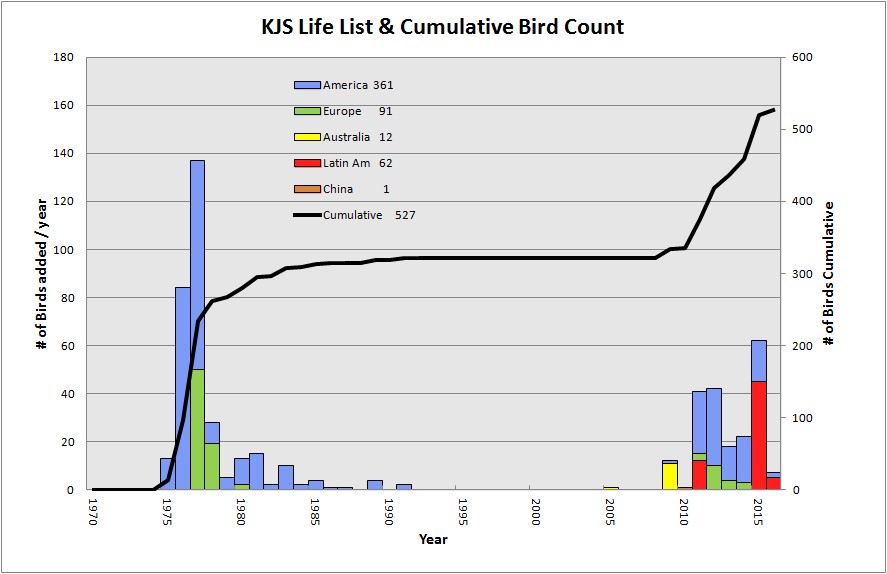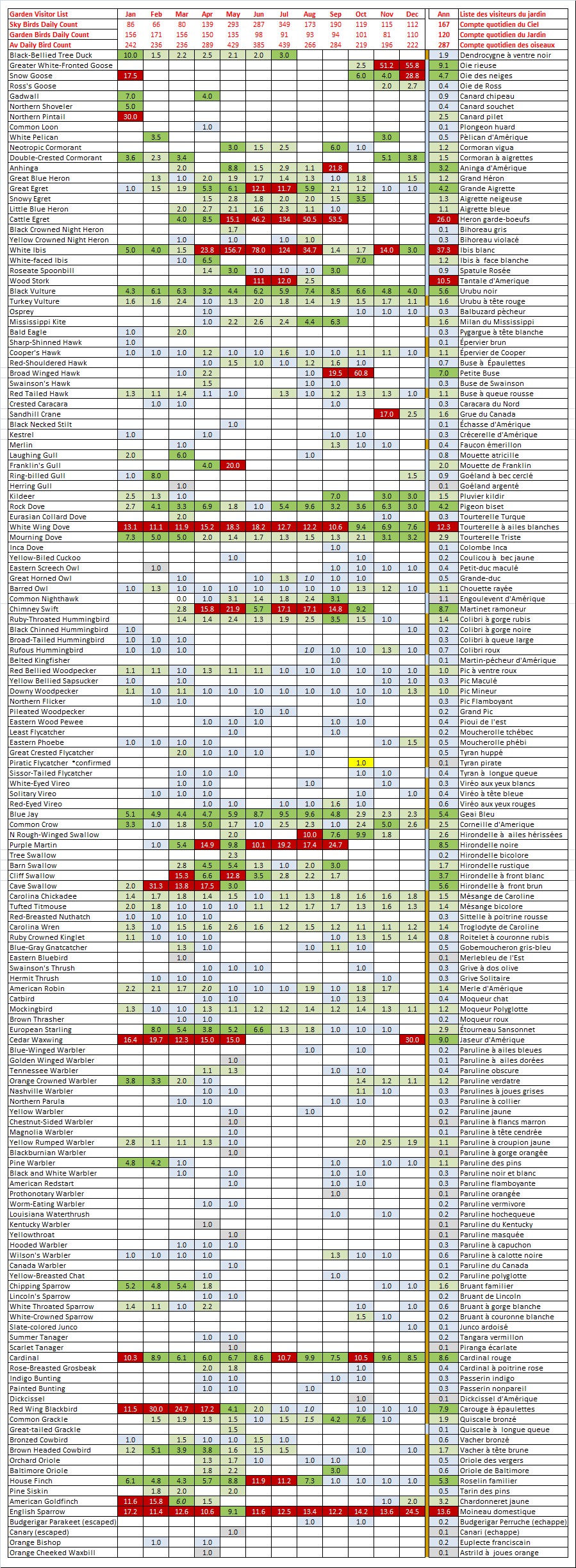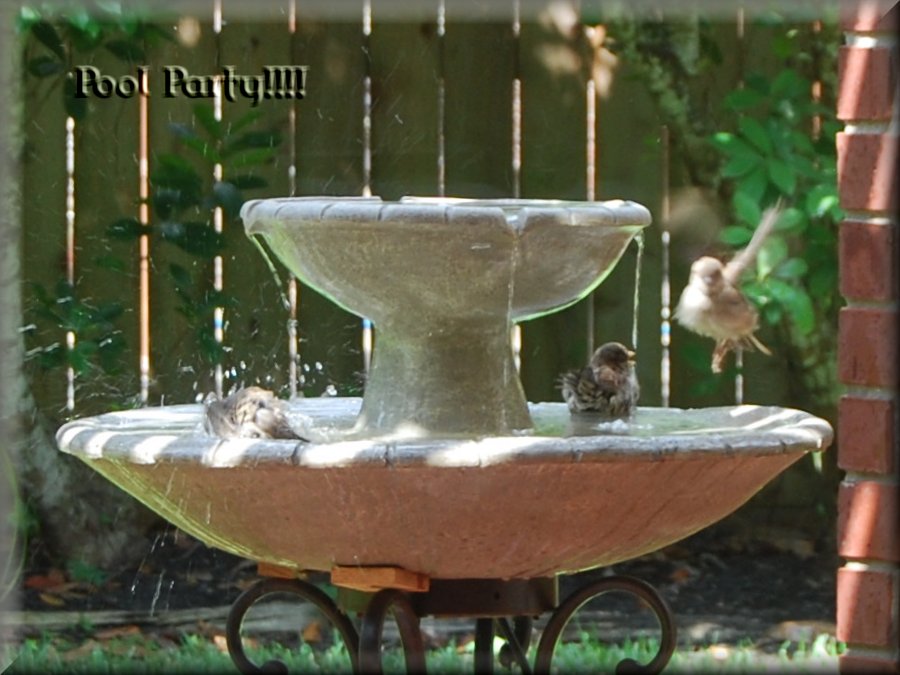My Life List of Bird Species Seen and Identified:
 This is a small page celebrating my many years of happy bird watching. All (most?) birders enjoy keeping various lists of species identified and I am certainly no exception. My experiences began as an undergraduate in Western Washington University where my friend Bob Maier and I took up the hobby with a passion. I have always been interested in natural sciences, astronomy, geology, biology, and in hiking and climbing in the high-country where many of my passions are combined. I began identifying wildflowers very early on many hikes with my parents and later with friends.
This is a small page celebrating my many years of happy bird watching. All (most?) birders enjoy keeping various lists of species identified and I am certainly no exception. My experiences began as an undergraduate in Western Washington University where my friend Bob Maier and I took up the hobby with a passion. I have always been interested in natural sciences, astronomy, geology, biology, and in hiking and climbing in the high-country where many of my passions are combined. I began identifying wildflowers very early on many hikes with my parents and later with friends.
Bird watching quickly became a major occupation for us as we explored the many coastal and upland swamps and praries in northwest Washington State. As the chart below indicates, My primary period of bird watching began in earnest in 1975 and continued until about 1978 or so. When I graduated from WWU, Bob and I parted, he to take up a life as a marine biologist and I to continue my MS in Geology at the University of Montana. Without my close friend to share my birding with my activity slowed. Additionally, much of the "easy" work had been done and I found it increasingly difficult to find species that I hadn't previously seen. Trips to Ireland and then to France did bring much happy hunting but the northwest was getting picked over.
I got married in 1980 to a lovely French lady, got a job, moved to Texas, we had a child (in Montana), and then another and another (both in Texas). All this soon put the breaks on my birding activity (although I always kept my eyes open). I was occasionally awarded with a new find. Still, it is a pity and shame that I didn't do more as I lived at this time on the Texas Gulf Coast in Houston.
My work afforded me many opportunities to travel around the globe, but kept me too busy to take advantage of the local birding, with an exception to a visit to Queensland and Australia's outback in 2009. Now I am retired and it is time to make up for some lost time here on the Gulf Coast. Much "Low-hanging Fruit" remains to be had I am sure. All in all I think a 420+ life list is a respectable accomplishment. Thanks much for taking the time to browse this page.
But first, a report from yours truly:
In recent decades Rufous hummingbirds have become increasingly common overwintering birds in the Gulf Coast and SE United States. In the Texas Gulf Coast / Houston area they are commonly noted on eBird each winter. This short report concerns the winter molt sequence observed in one Rufous hummingbird overwintering the 2020-2021 season in the west Houston suburb of Katy Texas.
PRIMARY MOLT PROGRESSION OF A RUFOUS HUMMINGBIRD WINTERING ON THE TEXAS GULF COAST: NOVEMBER 2020 - MARCH 2021 Smith, Kevin Joseph
A small gallery of bird pix I have taken, primarily just from the backyard feeder.
Backyard Beauties.. My wild visitors.....(with "garden" list below)
Birds of a feather.. Photos from here and there, and over there too.....
Birds from the American Southwest.. 2015 Road Trip plus Birding.....
Tropical Birdies from Costa Rica.. Because they are just so interesting!.....
Roost Rings over NW Houston.. NEXRAD catches annual Martin roosting.....
Bird Size and Velocity.. Birding by impression is not so magical as it may seem.....
Backyard Butterflies.. Another sweet consequence of planting a bird garden...
About the graph below, this shows my cumulative number of unique species identified. This does NOT correspond to a set of country/continent life lists as there is overlap, sometimes considerably, between species seen in different regions. I give priority to the country where I first see a bird and that generally, but not always, means America. Cheers!
Note on the photo at upper right: For three years now a little Carolina Wren couple have been nesting in a hanging basket on our back patio. They keep us entertained during meals as they diligently fly back and forth to the nest keeping hungry nestlings fed, such good parents! This early May they hatched three young who left the nest while we were sitting at the patio table. It was quite the scene as maman and papa worked first to entice them out of the nest, no easy task, and then to help lead them to the cover of nearby shrubbery. The babies could fly, kinda sorta, and one managed to land on the BBQ quite the wrong the direction from which maman wished him/her to go. There was much fuss and bother to sort the situation out. The confused little chick, all downy and new, finally managed to fly back to the nest before maman could call it on its way. Its a big scary world out there. We wish them all luck! See you next spring..


My garden list above. This is a record of the species diversity compiled on a monthly basis from January 2012 to December 2014. I typically spend my free time sitting out on the back patio tallying the fun out back, or reading when when things slow down. This is not an ebird list, no attempt to compile the numbers of each bird or hours spent, just my curiosity as to who is in and about, when to expect the little people to arrive or depart on migration, and generally watch the show. With some 90 different visitors so far I imagine this is no shabby resort for the birds.
For an eBird version of my garden list click here.
garden_ebird.docx
I compile a daily record for each day spent observing and summarize these by month in table above. This list includes those species who have been in, or proximate to the garden. My patio is covered and I have little view of the sky overhead, so the observations are basically limited to what I see in the garden itself. I do occasionally get out from under the cover and so include those birds that might otherwise not be expected to physically land in the garden, Purple Martins, Vultures, Ibis's and the like. Because of this I am unable to provide analysis of the monthly presence of these few species, just an indication that they were observed from whithin the confines of the garden. The majority of listed birds, 90+, do visit and get tallied. I present the data as a percentage reflecting the number of days a month a species is seen divided by the numbers of days spent looking. Some days I spend more time than others, oh well... This does provide a nice record of species monthly frequency and diversity. Aside the doldrums of high summer, the garden is a riot of activity with any number of high dramas playing out constantly. I have found there exist two basic states in the garden, either something is happening, or something is about to happen.
So, with all the listing, what really have I learned? I provide here a few fun stats compiled from my observations. To understand things, I first set about classifying my visitors according to residency as determined from ebird for my local area. Birds can be annual, or year-around residents, summer residents, winter residents, or spring/fall migrants, or finally I have also seen a few exotics. Of the nearly 90 species hosted in the garden, 36% are year-around residents, 28% winter over, only 9% are summer residents, and fully 25% are just passing through. 2% are exotic, one Budgerigar and one Canary both on the lam for sure.
I color code the cells by how much time the birds are around as follows: birds seen 90-100% of the time in red, 50-90% in dark green, 10-50% in light green, and less than 10% in light blue or grey. Grey is reserved for those species that have make one single visit only in the three years observing, 15 species. On an annulaized baseis, most of the birds do not spend huge amounts of time in the garden with 63 species around less than 10% of the year. Another 17 species have been around between 10 and 50% of the time. Seven species between 50 and 90% of the time and only two truly dependable species spending over 90% of the year hanging out in the garden, english sparrows (why am I not surprised) and Cardinals. This is much of the fun and interest in birding, the seasonality of the visitors, things are always changing. The monthly species counts listed at the top of the table tells the story with March through May averaging nearly 50 species per month while summer delivers only about half that, some 25 species per month, but the drama of children everywhere.


All the above "learnings" are just the visible tip, that which is easily presented in charts and graphs. Observing the birds, their behavoirs, their disputes, their arrivals and departures, one learns much. I do not keep systematic notes but in my photos section I include many interesting observations along with my usual anthropomorphizing.
Below a chart chowing the numbers of each species visiting daily by month.

Cheers!
kjs
ps. Birding is an old hobby dating back to the late middle ages at least!
Saint Francis of Assisi's Sermon to the Birds.. c1220

 This is a small page celebrating my many years of happy bird watching. All (most?) birders enjoy keeping various lists of species identified and I am certainly no exception. My experiences began as an undergraduate in Western Washington University where my friend Bob Maier and I took up the hobby with a passion. I have always been interested in natural sciences, astronomy, geology, biology, and in hiking and climbing in the high-country where many of my passions are combined. I began identifying wildflowers very early on many hikes with my parents and later with friends.
This is a small page celebrating my many years of happy bird watching. All (most?) birders enjoy keeping various lists of species identified and I am certainly no exception. My experiences began as an undergraduate in Western Washington University where my friend Bob Maier and I took up the hobby with a passion. I have always been interested in natural sciences, astronomy, geology, biology, and in hiking and climbing in the high-country where many of my passions are combined. I began identifying wildflowers very early on many hikes with my parents and later with friends. 




